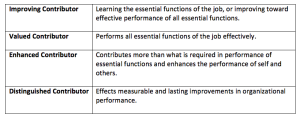Why Words Matter in Employee Evaluation Systems
Posted by Matt • October 8, 2015 (Last modified July 29, 2018) • 3 min read
Use your words. It’s very likely that many of us have heard or used this phrase at some point in our lives. For me, it brings up memories of my childhood. My parents would often use this in an attempt to help me describe something, or just to communicate my opinion. Sounds pretty simple, right?
Then it should then be no surprise that the words we use play one of the largest roles in employee evaluations. During the appraisal process, the conversations we have can inspire professional growth and ignite positive change. More so, the ratings we select on a scale when evaluating an employee’s performance can make an impact on someone’s ability to embrace feedback and grow. This provides all the more reason to implement a rating scale that will match your culture and be effective for your organization.
A few things to consider
First, how many levels (or points) will your scale need to be effective? If you are interested in avoiding ‘average’ ratings, you may consider using an even-numbered scale, such as a 4-point scale.
Or, perhaps more flexibility as well as the opportunity to have more differentiation between performance levels is ideal for you. If so, then a 5-point scale is an effective choice.
Keep in mind that your rating scale will need enough points to extract meaningful data, especially considering how it will relate to employee development and improvement moving forward.
Each level must be clearly defined, used consistently by managers, and fit with the organization’s culture. As noted in SHRM’s standard on performance management –
“Raters should be provided with examples of behaviors, skills, measurements, and other data that will assist them in making a decision regarding the performance level.”
Semi-Quantitative Approach
In aligning with this model, many organizations today have found much success with a simple descriptive approach. This refers to a semi-quantitative scale that would require the appraiser to rank the employee’s performance on a scale that uses descriptors, as opposed to numbers. For example, one point on the scale may be ‘Exceeds Expectations’, which is described as ‘clearly exceeds job requirements’.
In terms of popularity, a 5-point descriptive scale is at the top of the list. We see this type of scale as advantageous for organizations because it provides concrete measures that enable managers to compare employee performance across teams or entire divisions. Not only are they more descriptive than numeric options, they also allow for much more specific feedback.
Scales often include ratings such ‘Exceeds, Meets, Needs Improvement’, however some fear that this puts the reviewer in the position to judge the employee. We are seeing a growing trend where some organizations have taken it a step further by implementing a descriptive scale geared towards positive messaging. A scale as such may include ratings like ‘Highly Effective’ or ‘Basic’. An effort to avoid judgment in the negative sense, the rating scale is based on how often behaviors, skills, and attributes are observed. An example we love here:
Performance reviews are an opportunity for managers to have a positive impact on employees’ performance. Ensure that your managers are onboard and know how to use any rating scale you choose to influence performance and the performance appraisal. We believe that while a rating scale may seem like a minor decision when designing your employee evaluation system it can be one of the most effective tools in managing, reporting and developing performance.
Don't Miss Out on More Great HR Articles!
Subscribe to get the latest, greatest HR and Talent Development content straight to your inbox.



